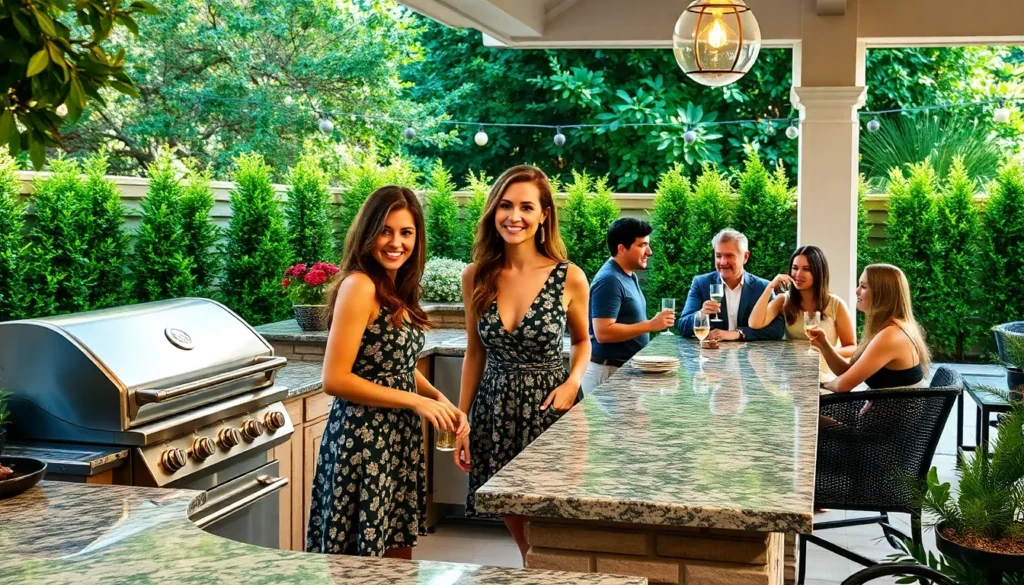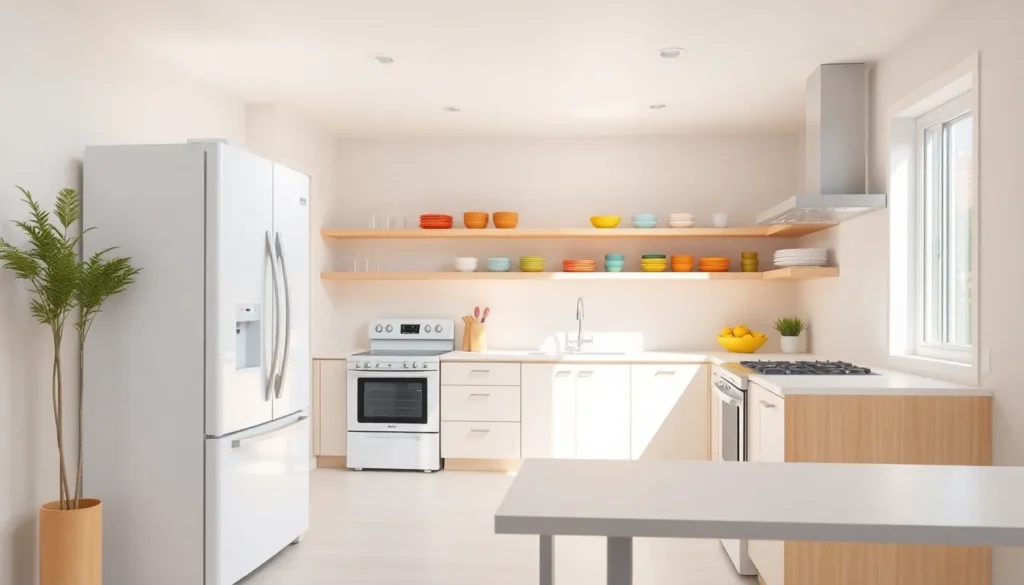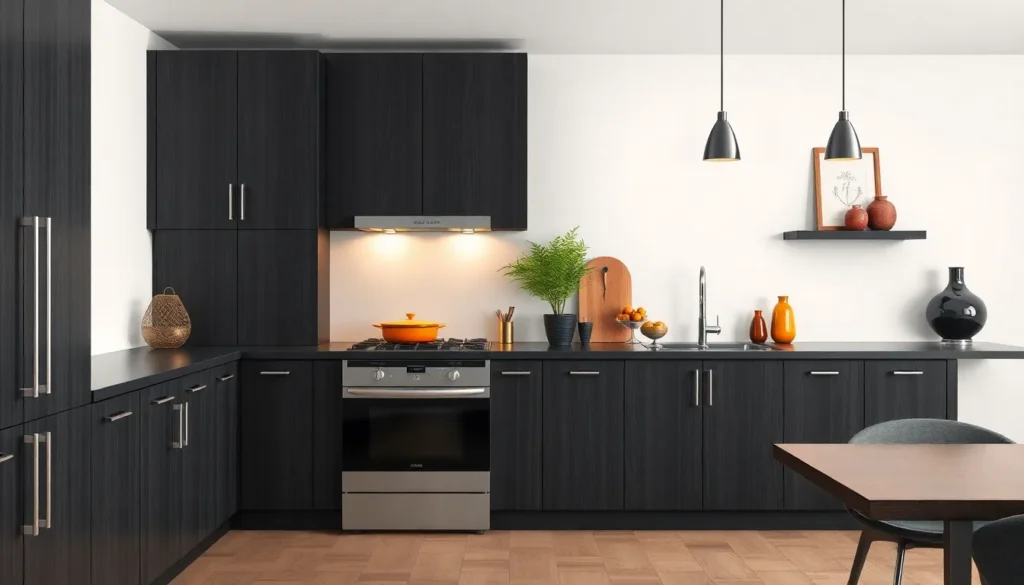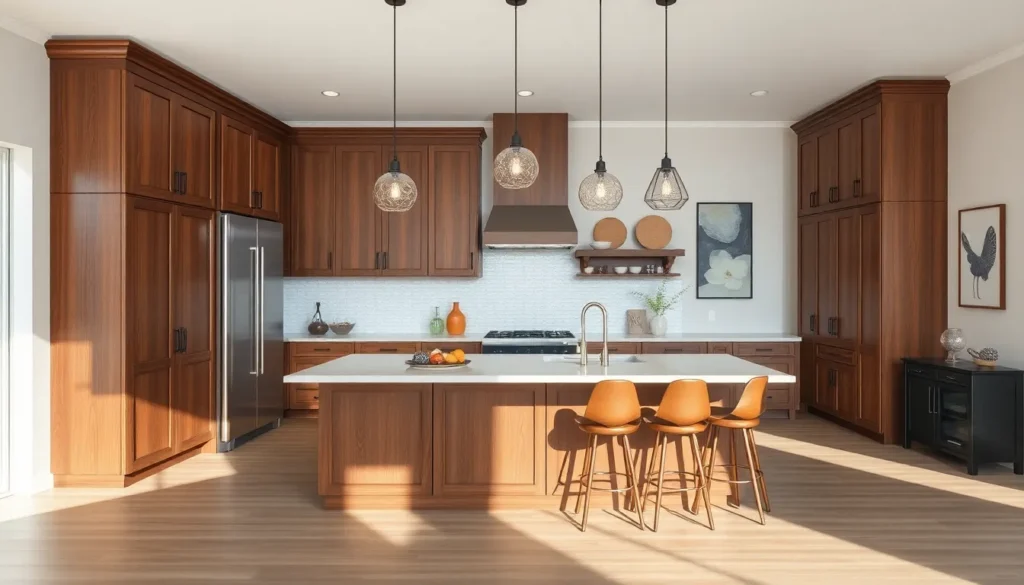In a world where bigger often seems better, tiny house kitchens prove that good things really do come in small packages. Imagine whipping up a gourmet meal in a space that’s cozier than your favorite coffee shop. These pint-sized culinary havens challenge the notion that size limits creativity. With clever design and a sprinkle of ingenuity, they transform cooking into an art form, even if it means occasionally bumping elbows with the fridge.
Tiny house kitchens aren’t just about downsizing; they’re about maximizing every inch of space while keeping your culinary dreams alive. Whether it’s a fold-out table or a hidden pantry, these kitchens pack a punch without the clutter. So, if you’ve ever fantasized about living simply but don’t want to sacrifice your love for cooking, get ready to explore the whimsical world of tiny house kitchens. Who knew small could taste so good?
Table of Contents
ToggleOverview of Tiny House Kitchens
Tiny house kitchens exemplify ingenuity in design and functionality. They combine compact layouts with efficient storage solutions. Limited space encourages creative use of every inch. For instance, homeowners often install cabinets that extend to the ceiling. These high cabinets maximize vertical storage while keeping essential items within reach.
The arrangement of appliances in tiny kitchens matters greatly. Many choose to integrate multi-functional devices like convection ovens that can roast, bake, and microwave. This versatility allows for diverse meal preparation in a limited footprint. Additionally, portable induction cooktops save counter space while providing effective cooking options.
Countertops frequently serve multiple purposes in these kitchens. They function as prep areas while also acting as dining spaces. Foldable tables and retractable countertops allow for a flexible living environment. Such additions enable homeowners to customize their space as needed, accommodating both cooking and dining.
Lighting proves crucial in tiny kitchens. Natural light enhances the sense of openness, while strategically placed fixtures improve visibility. Under-cabinet lighting often creates an inviting atmosphere and highlights culinary activities.
Color choices can significantly influence the perception of space. Light colors on walls and cabinetry promote an airy feel. Accents in darker shades can add depth and character without overwhelming the area.
Tiny house kitchens showcase how functionality and charm coexist in smaller living spaces. They inspire creative approaches to cooking, emphasizing that limited square footage does not restrict culinary aspirations. With thoughtful design and smart choices, these kitchens transform into delightful epicenters of life and nourishment.
Key Features of Tiny House Kitchens
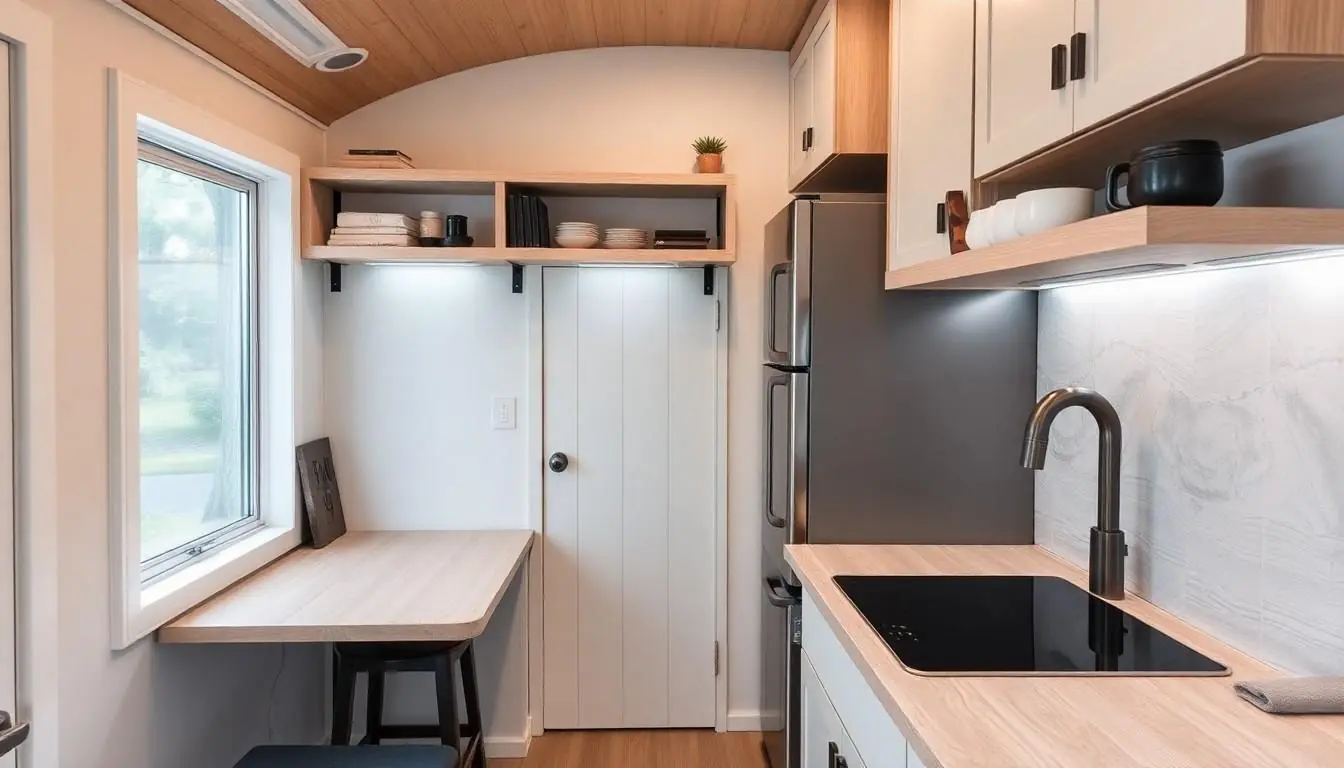
Tiny house kitchens exemplify innovative design and efficient use of limited space. Homeowners employ several features that maximize functionality while maintaining charm.
Space-Saving Solutions
Innovative layouts play a crucial role in tiny house kitchens. Fold-down tables create dining areas that disappear when not in use, offering versatility. Drawer organizers help maximize storage in cabinets, efficiently housing utensils and cookware. Custom shelving units take advantage of wall space without requiring bulky furniture, keeping the room open and airy. Magnetic strips hold knives while freeing up counter space, enhancing safety and accessibility. Under-cabinet lighting illuminates prep areas without occupying valuable surface space.
Essential Appliances
Multi-functional appliances form the backbone of tiny house kitchen setups. Convection ovens provide baking, roasting, and broiling capabilities within one compact unit. Induction cooktops offer powerful cooking options without the space demands of traditional stoves. Compact refrigerators designed for small spaces maintain food freshness without overpowering the kitchen. Dishwashers with slim profiles save water and are useful in maintaining cleanliness, particularly in tight quarters. Coffee makers and toasters often double as countertop decorations, enhancing aesthetic appeal while remaining functional.
Design Considerations
Tiny house kitchens require thoughtful design to effectively utilize limited space while offering functionality and charm. Key elements include the layout and aesthetic choices to enhance both efficiency and visual appeal.
Layout and Workflow
Efficient layouts prioritize flow, ensuring ease of movement within the compact space. A triangle layout, connecting the refrigerator, sink, and cooktop, optimizes convenience for culinary tasks. Integrating open shelving allows for easy access to frequently used items, while also maintaining an airy feel. Positioning work surfaces near appliances enhances workflow, reducing unnecessary steps when preparing meals. Below-counter storage maximizes available space and keeps essentials organized.
Aesthetic Choices
Aesthetic choices establish the kitchen’s overall atmosphere, essential in a tiny home. Light color palettes create an illusion of openness, making the space feel larger. Incorporating natural materials, like wood and stone, adds warmth and character. Multi-functional furniture, such as a kitchen island with seating, serves both decorative and practical purposes. Thoughtful lighting, like under-cabinet fixtures, enhances visibility while creating an inviting ambiance. Personal touches, such as decorative accents or potted herbs, infuse warmth and personality into the compact kitchen environment.
Tips for Maximizing Functionality
Innovative storage solutions prove essential in tiny house kitchens. Utilizing vertical space by installing high cabinets or shelves increases storage capacity without crowding. Consider applying drawer organizers to maximize every nook, ensuring tools and utensils remain accessible.
Multi-functional appliances play a key role in optimizing space. Choosing compact convection ovens and portable induction cooktops enhances cooking options while occupying minimal counter area. Integrating appliances that serve more than one purpose, like a microwave that also acts as a convection oven, streamlines functionality.
Countertops also provide opportunities for multitasking. Using fold-down tables offers both prep space and dining areas, saving valuable square footage. Some homeowners opt for movable islands that can adapt based on current needs.
Light colors create a more spacious feel in tiny kitchens. Bright hues reflect light and help the area feel open, while natural materials further enhance warmth. Personal touches, like decorative plants or art, add character without overwhelming the space.
Thoughtful lighting elevates both functionality and ambiance. Under-cabinet lighting brightens work surfaces while creating a cozy atmosphere. Using adjustable fixtures allows users to customize lighting based on specific tasks.
Space-efficient layouts remain vital to maximizing kitchen utility. Arranging essential appliances in a triangle enhances convenience and workflow. Adopting open shelving enables quick access to frequently used items while maintaining an airy environment.
Popular Tiny House Kitchen Styles
Modern tiny house kitchens embrace various styles, each with distinct features and practical solutions.
- Minimalist Style
Minimalist kitchens focus on simplicity, utilizing clean lines and uncluttered spaces. Neutral colors and functional furniture define this approach, promoting a serene cooking environment.
- Rustic Style
Rustic kitchens evoke warmth with wood accents and vintage finishes. Reclaimed wood countertops and open shelving create a cozy atmosphere, while farmhouse sinks and natural materials enhance the charm.
- Industrial Style
Industrial kitchens showcase raw elements like metal, concrete, and exposed piping. This style emphasizes functionality with large appliances and space-efficient designs. High ceilings and large windows contribute to an open feel.
- Modern Farmhouse Style
Modern farmhouse kitchens blend contemporary design with traditional elements. Shaker cabinets and mixed materials create visual interest. Incorporating farmhouse sinks and large islands promotes practicality in small spaces.
- Scandinavian Style
Scandinavian kitchens highlight functionality and simplicity. Light wood, white colors, and minimal decor foster a sense of openness. Multi-functional furniture and clever storage solutions maximize space efficiency.
- Eclectic Style
Eclectic kitchens celebrate individuality through bold colors and unique decor. Mixing patterns and textures allows homeowners to express personal style while maintaining functionality.
- Contemporary Style
Contemporary kitchens integrate sleek designs with the latest technology. High-gloss finishes and cutting-edge appliances reflect modern living. Open layouts enhance the flow between spaces.
These various tiny house kitchen styles illustrate how creativity and functionality mesh seamlessly, providing homeowners with flexible solutions to suit their tastes and lifestyles. Each style offers unique advantages while focusing on maximizing space and enhancing culinary experiences.
Tiny house kitchens prove that size isn’t everything when it comes to functionality and style. With thoughtful design and clever storage solutions, these compact spaces can inspire culinary creativity and elevate everyday cooking experiences.
The blend of aesthetics and practicality allows homeowners to enjoy a cozy atmosphere while maximizing every inch available. Whether opting for a minimalist look or embracing rustic charm, tiny house kitchens can reflect personal tastes while remaining efficient.
Ultimately, these kitchens demonstrate that a smaller footprint can lead to innovative solutions and a fulfilling cooking environment, allowing anyone to embrace a simpler lifestyle without sacrificing their culinary passions.




